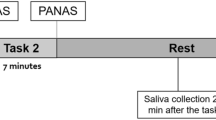Abstract
Computerized testing can induce behavioral signs of frustration in apes. Three variations of a computer task were used to investigate the effects of inter-trial intervals and rate of cursor movement on frustrative behavior and cortisol in an orangutan. Behaviors were recorded during test sessions, and saliva was collected immediately after test sessions for cortisol assay. Behavioral results indicated that extended (20 sec) periods of delay between trials induced signs of frustration in the subject, including forceful manual manipulation of objects and self-scratching. However, cortisol results indicated that Hypothalamic-Pituitary-Adrenal (HPA) axis activity was not induced by task performance. Rather, cortisol levels were reduced during performance of computer tasks compared to baseline levels. Findings from this study suggest that behavioral and cortisol responses to stress induced by performance of computer testing can become dissociated. This study validates salivary cortisol as a measure of HPA activity in apes and demonstrates a normal circadian rhythm of cortisol release in an orangutan.
Similar content being viewed by others
References
Aureli, F.;van Schaik, C. P. 1991. Post-conflict behaviour in long-tailed macaques (Macaca fascicularis): II. Coping with uncertainty.Ethology, 89: 101–114.
Beerda, B.;Schilder, M. B.;Janssen, N. S.;Mol, J. A. 1996. The use of saliva cortisol, urinary cortisol, and catecholamine measurements for a noninvasive assessment of stress responses in dogs.Horm. Behav., 30: 272–279.
Boyce, W. T.;Champoux, M.;Suomi, S. J.;Gunnar, M. R. 1995. Salivary cortisol in nursery-reared rhesus monkeys: reactivity to peer interactions and altered circadian activity.Dev. Psychobiol., 28: 257–267.
Castles, D. L.;Whiten, A. 1998. Post-conflict behaviour of wild olive baboons: II. Stress and self-directed behaviour.Ethology, 104: 148–160.
Castles, D. L.;Whiten, A.;Aureli, F. 1999. Social anxiety, relationships and self-directed behaviour among wild female olive baboons.Anim. Behav., 58: 1207–1215.
Champoux, M.;Zanker, D.;Levine, S. 1993. Food search demand effort effects on behavior and cortisol in adult female squirrel monkeys.Physiol. Behav., 54: 1091–1097.
Coe, C. L.;Stanton, M. E.;Levine, S. 1983. Adrenal responses to reinforcement and extinction: role of expectancy versus instrumental responding.Behav. Neurosci., 97: 654–657.
Coover, G. D.;Goldman, L.;Levine, S. 1971. Plasma corticosterone increases produced by extinction of a lever-press response in rats.Physiol. Behav., 6: 261–263.
Croes, S.;Merz, P.;Netter, P. 1993. Cortisol reaction in success and failure condition in endogenous depressed patients and controls.Psychoneuroendocrinology, 18: 23–35.
Czekala, N. M.;Lance, V. A.;Sutherland-Smith, M. 1994. Diurnal urinary corticoid excretion in the human and gorilla.Amer. J. Primatol., 34: 29–34.
Dunn, A. J.;Berridge, C. W. 1990. Physiological and behavioral responses to corticotropin-releasing factor administration: is CRF a mediator of anxiety or stress responses?Brain Res. Rev., 15: 71–100.
Gunnar, M. R.;Connors, J.;Isensee, J.;Wall, L. 1998. Adrenocortical activity and behavioral distress in human newborns.Dev. Psychobiol., 21: 297–310.
Hennessy, M. B.;Mendoza, S. P.;Mason, W. A.;Moberg, G. P. 1995. Endocrine sensitivity to novelty in squirrel monkeys and titi monkeys: species differences in characteristic modes of responding to the environment.Physiol. Behav., 57: 331–338.
Henry, J. P. 1992. Biological basis of the stress response.Integr. Physiol. Behav. Sci., 27: 66–83.
Hoffman, K. A.;Mendoza, S. P.;Hennessy, M. B.;Mason, W. A. 1995. Responses of infant titi monkeys,Callicebus moloch, to removal of one or both parents: evidence for paternal attachment.Dev. Psychobiol., 28: 399–407.
Itakura, S. 1993. Emotional behavior during the learning of a contingency task in a chimpanzee.Percept. Mot. Skills, 76: 563–566.
Kirschbaum, C.;Hellhammer, D. H. 1994. Salivary cortisol in psychoneuroendocrine research: recent developments and applications.Psychoneuroendocrinology, 19: 313–333.
Krieger, D. T.;Allen, W.;Rizzo, F.;Krieger, H. P. 1971. Characterization of the normal temporal pattern of plasma corticosteroid levels.J. Clin. Endocrinol., 32: 266–284.
Leavens, D. A.;Aureli, F.;Hopkins, W. D.;Hyatt, C. W. 2001. Effects of cognitive challenge on self-directed behaviors by chimpanzees (Pan troglodytes).Amer. J. Primatol., 55: 1–14.
Lewis, M.;Ramsay, D. S.;Kawakami, K. 1993. Differences between Japanese and Caucasian American infants in behavioral and cortisol response to inoculation.Child Dev., 64: 1722–1731.
Lyons, D. M.;Kim, S.;Schatzberg, A. F.;Levine, S. 1998. Postnatal foraging demands alter adrenocortical activity and psychosocial development.Dev. Psychobiol., 32: 285–291.
Maestripieri, D.;Schino, G.;Aureli, F.;Troisi, A. 1992. A modest proposal: displacement activities as an indicator of emotions in primates.Anim. Behav., 44: 967–979.
Peters, M. L.;Godaert, G. L.;Ballieux, R. E.;van Vliet, M.;Willemsen, J. J.;Sweep, F. C.;Heijnen, C. J. 1998. Cardiovascular and endocrine responses to experimental stress: effects of mental effort and controllability.Psychoneuroendocrinology, 23: 1–17.
Plant, T. M. 1981. Time courses of concentrations of circulating gonadotropin, prolactin, testosterone, and cortisol in adult male rhesus monkeys throughout the 24 h light-dark cycle.Biol. Reprod., 25: 244–252.
Robbins, M. A.;Czekala, N. M. 1997. A preliminary investigation of urinary testosterone and cortisol levels in wild male mountain gorillas.Amer. J. Primatol., 43: 51–64.
Rose, R. M.;Jenkins, D.;Hurst, M.;Herd, J. A.;Hall, R. P. 1982. Endocrine activity in air traffic controllers at work: II. Biological, psychological, and work correlates.Psychoneuroendocrinology, 7: 113–123.
Sapolsky, R. M. 1992. Neuroendocrinology of the stress response. In:Behavioral Endocrinology,Becker,J. B.;Breedlove,S. M.;Crews,D. (eds.), MIT Press, London, pp. 287–324.
Siegel, S.;Castellan, N. J. 1988.Nonparametric Statistics for the Behavioral Sciences (2nd ed.). McGraw Hill, New York.
Smith, C. J.;Norman, R. L. 1987. Influence of the gonads on cortisol secretion in female rhesus macaques.Endocrinology, 121: 2192–2198.
Smith, T. E.;French, J. A. 1997. Psychosocial stress and urinary cortisol excretion in marmoset monkeys (Callithrix kuhli).Physiol. Behav., 62: 225–232.
Troisi, A.;Schino, G.;D’Antoni, M.;Pandolfi, N.;Aureli, F.;D’Amato, F. R. 1991. Scratching as a behavioral index of anxiety in macaque mothers.Behav. Neural Biol., 56: 307–313.
Washburn, D. A.;Rumbaugh, D. M. 1992. Investigations of rhesus monkey video-task performance: evidence for enrichment.Contemp. Top., 31: 6–10.
Whiten, P. L.;Tavisky, R.;Aureli, F.;Russell, E. 1998. Response of fecal cortisol to stress in captive chimpanzees (Pan troglodytes).Amer. J. Primatol., 44: 57–69.
Author information
Authors and Affiliations
Corresponding author
About this article
Cite this article
Elder, C.M., Menzel, C.R. Dissociation of cortisol and behavioral indicators of stress in an orangutan (Pongo pygmaeus) during a computerized task. Primates 42, 345–357 (2001). https://doi.org/10.1007/BF02629625
Received:
Accepted:
Issue Date:
DOI: https://doi.org/10.1007/BF02629625




